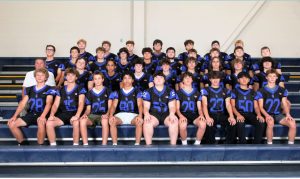Addressing Traffic at Hollis Brookline
January 26, 2018
Terrible morning and afternoon traffic has been part of the culture at Hollis Brookline for as long as anyone can remember. Even after the change in start time, the familiar feeling of sitting in line 300 meters away from the front door 10 minutes before school starts and then still being late to class hit students square in the face once again this fall. Countless times over the last few years, conversations have sparked regarding possible fixes to the issue, but no group has gone beyond this stage. In the interest of student and staff safety, as well as transportation efficiency, the Cavalier Chronicle staff investigated this matter thoroughly.
Assistant Sports Editor Mark Labak took the liberty of recording the timestamps of a typical ride home as he reached key landmarks in the area. An interactive timeline can be found below:
After reviewing the timeline, many disturbing realities arise from possible evacuation safety issues, wasted time for those rushing off to their line of employment, and those students heading home for essential child care/caretaking. These are just among any other number of issues beyond the scope of this article, such as environmental stain or noise pollution. In an effort to alleviate some of the negative effects of this issue, the staff here at CavChron took on the task of investigating a series of recommendations to the co-op school board, SAU41 administration, and concerned community members.
Proposed Solution #1-Relining of the school driveway and relocating student drop off
The first proposed solution looks to improve the flow of morning traffic after we noticed a few key flaws in the design of the transportation area. To begin, the way the traffic pattern is set up currently, 100% of vehicular volume travels along the one way street of Cavalier Rd, which is the extension loop to the backlot parking area of Cavalier Ct. Currently, there is a choke point, defined as a point of congestion or blockage, 364 feet beyond the front crosswalk that students use to cross from the long sidewalk to the front of the school. The choke point, to no surprise, is caused by a split in traffic, with the majority of cars going off toward the right into the backlot and the minority of cars staying straight ahead to wait in the student drop off line.
While this seems like a fine traffic pattern, the short nature of the student drop off area, just around 200 feet long, and the one lane nature of the road, it only takes around 8 cars to create a traffic jam. This is due to the combination of amount of time that it takes for a student to get out of their car, usually around 20 seconds, and the reality that this short line of cars is directly behind a major crosswalk for students to get into the school from the parking area. With early arriving students walking from their cars in a very spaced and scattered fashion, it is nearly impossible for a line of 8 carpool cars to clear out in under a minute ten to fifteen minutes before the start of the school day. With this line of cars backed up into the one way street, blocking the split for students to enter the parking lot, this creates a long traffic jam of around 250 cars trying to get to the backlot.
This is a classic example of a minority of drivers causing a major issue, to no fault of their own: the traffic pattern was designed to fail.
This first solution proposes that the student drop off line be moved to the front area of the school. This can be achieved with three different aspects:
Solution #1: part one-front drop off line
The busses that drop off students are in the process of clearing out at 7:20am, having already unloaded most students. These buses sit in a single file line closest to the sidewalk in the front of the school. Keeping this in mind, the front drive where they sit is designed to be two bus length’s wide, more than wide enough for a line of cars. The first proposed solution would be to have the student drop off line be in the left, currently open, lane of the front driveway, with buses having the right of way. The issue of the buses exiting is almost nonexistent due to them leaving the campus long before even a fraction of the student drop off traffic arrives.
By moving it to the front area, 100% of the volume going into the back parking lot would be staying there, without any sort of splitting in travel, which allows for a smooth flow of traffic.
part two-cost effectively creating a turning lane
By only moving the front drop off line to the front without any other changes, this would just be moving the choke point of traffic to a different location, rather than just alleviating the issue. Luckily, this solution can utilize a flaw in the lining of the asphalt.
In coming up the driveway driveway from main street, a one way, there is a newly painted double yellow line successfully defining the entry and exit lanes from the school. Interestingly enough, after about 1000 feet up the driveway, right next to stop sign B (see photo), the double yellow line continues unnecessarily for around 128 feet before disappearing at the start of the teacher’s parking area. This is an unnecessary double yellow line, because that section of the driveway has been and always will be a one way street. This is a waste of a second lane that, currently, can never be used. By changing the double yellow lines to a dotted white line for this 128 foot strip, this will create the possibility of a turning lane for buses going left, the student drop off parents going left, and the teachers going left into their parking lot.
As it turns out, according to Hollis Police Officer and SRO, Richard Bergeron, there is no organization or law that has jurisdiction over the lining of the traffic way other than the SAU41 school board, making this a relatively inexpensive and easy task to take on.
part three-inform the public
Finally, the last aspect of this solution would be to inform the public and change the current, already outdated traffic signs that became obsolete after the implementation of the new co-op start times. These signs would help inform the public of the new traffic pattern, assisting in the rewiring of the public’s habit.
These solutions were assisted in development by Adam Wilcox, a leading member of HB’s Physics department and an experienced engineer with past projects such as the Madison Square Garden renovation in New York.
Solution #2-Removing an unnecessary stop sign and putting it in the proper place
In regard to traffic leaving the school in the afternoon, there is another flaw that has been given special attention throughout the years: there is a stop sign where there shouldn’t be. When leaving the backlot, it is not uncommon to see around 50% of students blow through it due to there not being any traffic coming from the front of the school in the evening. Not only that, but the stop sign should, according to typical traffic patterns, be shifted to face the front of the school direction rather than the traffic coming from the back lot, which should theoretically have the right of way. While there is no body regulating the stop sign placement, there is a specific process that must be completed in order to have any stop signs be enforced by the police department.
In changing the stop sign placement, the flow of traffic from the backlot will be improved due to alleviating the “inset here” effect, made famous by YouTuber CGPGrey in his video “The Simple Solution to Traffic.” In an attached .gif file image (click to view), the effect of one car slightly breaking and its effects on the rest of the line of traffic can be seen in a simple circular setting. While this plan cannot alleviate the volume that passes through the existing driveway, due to there only being one lane, it can assist in the speed of that volume passing through for zero cost.
Discussion:
These are just two of countless, cost effective ways to help alleviate the negative effects of traffic on students, staff, and the greater community. As a paper, we urge action to be taken to avoid tragedies that have occurred in the past, including students being hit by cars and fender bender collisions.
Jennifer Given, a member of the HBHS social studies department and the advisor of the student government, cited that much of the proposed solutions in the past have been put off due to the length of the projects, as well as the need of great financial backing. She felt it is necessary for there to be smaller solutions, like those proposed above, to be instituted first before turning to more pressing traffic issues such as the flawed four corner light and the lack of two entry/exit points in the school. “We need to deal with what we can at the moment, with solutions that are within our control. These are on the right track,” she said earlier this week.
Want to express your opinion of the traffic mater? Comment below!


















![Students in Archaeology use tools in a mock excavation. As a class that focuses on hands-on learning, students are able to gain crucial life skills. “[The class] is more hands-on than I thought, and I'm learning way more with physical activities than I do in the classroom,” said student Tess Brown ‘25.](https://cavchronline.com/wp-content/uploads/2024/11/IMG_8390-e1733078359165-278x300.jpg)